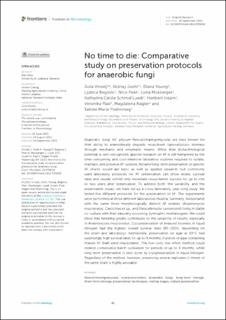Please use this identifier to cite or link to this item:
https://doi.org/10.21256/zhaw-25752| Publication type: | Article in scientific journal |
| Type of review: | Peer review (publication) |
| Title: | No time to die : comparative study on preservation protocols for anaerobic fungi |
| Authors: | Vinzelj, Julia Joshi, Akshay Young, Diana Begovic, Ljubica Peer, Nico Mosberger, Lona Luedi, Katharina Cécile Schmid Insam, Heribert Flad, Veronika Nagler, Magdalena Podmirseg, Sabine Marie |
| et. al: | Yes |
| DOI: | 10.3389/fmicb.2022.978028 10.21256/zhaw-25752 |
| Published in: | Frontiers in Microbiology |
| Volume(Issue): | 13 |
| Issue: | 978028 |
| Issue Date: | 2022 |
| Publisher / Ed. Institution: | Frontiers Research Foundation |
| ISSN: | 1664-302X |
| Language: | English |
| Subjects: | Environmental biotechnology; Neocallimastigomycota; Cryopreservation; Anaerobic fungus; Long-term storage; Short-term storage; Preservation technique; Resting stage; Culture preservation |
| Subject (DDC): | 579: Microbiology 660.6: Biotechnology |
| Abstract: | Anaerobic fungi (AF, phylum Neocallimastigomycota) are best known for their ability to anaerobically degrade recalcitrant lignocellulosic biomass through mechanic and enzymatic means. While their biotechnological potential is well-recognized, applied research on AF is still hampered by the time-consuming and cost-intensive laboratory routines required to isolate, maintain, and preserve AF cultures. Reliable long-term preservation of specific AF strains would aid basic as well as applied research, but commonly used laboratory protocols for AF preservation can show erratic survival rates and usually exhibit only moderate resuscitation success for up to one or two years after preservation. To address both, the variability, and the preservation issues, we have set up a cross-laboratory, year-long study. We tested five different protocols for the preservation of AF. The experiments were performed at three different laboratories (Austria, Germany, Switzerland) with the same three morphologically distinct AF isolates (Anaeromyces mucronatus, Caeocmyces sp., and Neocallimastix cameroonii) living in stable co-culture with their naturally occurring, syntrophic methanogens. We could show that handling greatly contributes to the variability of results, especially in Anaeromyces mucronatus. Cryopreservation of (mature) biomass in liquid nitrogen had the highest overall survival rates (85–100%, depending on the strain and laboratory). Additionally, preservation on agar at 39°C had surprisingly high survival rates for up to 9 months, if pieces of agar containing mature AF thalli were resuscitated. This low-cost, low-effort method could replace consecutive batch cultivation for periods of up to 6 months, while long-term preservation is best done by cryopreservation in liquid nitrogen. Regardless of the method, however, preserving several replicates (>three) of the same strain is highly advisable. |
| URI: | https://digitalcollection.zhaw.ch/handle/11475/25752 |
| Fulltext version: | Published version |
| License (according to publishing contract): | CC BY 4.0: Attribution 4.0 International |
| Departement: | Life Sciences and Facility Management |
| Organisational Unit: | Institute of Chemistry and Biotechnology (ICBT) |
| Published as part of the ZHAW project: | Entfesselung des versteckten Potentials anaerober Pilze (Neocallimastigomycota) |
| Appears in collections: | Publikationen Life Sciences und Facility Management |
Files in This Item:
| File | Description | Size | Format | |
|---|---|---|---|---|
| 2022_Vinzelj-etal_Preservation-protocols-for-anaerobic-fungi-study.pdf | 4.16 MB | Adobe PDF |  View/Open |
Show full item record
Vinzelj, J., Joshi, A., Young, D., Begovic, L., Peer, N., Mosberger, L., Luedi, K. C. S., Insam, H., Flad, V., Nagler, M., & Podmirseg, S. M. (2022). No time to die : comparative study on preservation protocols for anaerobic fungi. Frontiers in Microbiology, 13(978028). https://doi.org/10.3389/fmicb.2022.978028
Vinzelj, J. et al. (2022) ‘No time to die : comparative study on preservation protocols for anaerobic fungi’, Frontiers in Microbiology, 13(978028). Available at: https://doi.org/10.3389/fmicb.2022.978028.
J. Vinzelj et al., “No time to die : comparative study on preservation protocols for anaerobic fungi,” Frontiers in Microbiology, vol. 13, no. 978028, 2022, doi: 10.3389/fmicb.2022.978028.
VINZELJ, Julia, Akshay JOSHI, Diana YOUNG, Ljubica BEGOVIC, Nico PEER, Lona MOSBERGER, Katharina Cécile Schmid LUEDI, Heribert INSAM, Veronika FLAD, Magdalena NAGLER und Sabine Marie PODMIRSEG, 2022. No time to die : comparative study on preservation protocols for anaerobic fungi. Frontiers in Microbiology. 2022. Bd. 13, Nr. 978028. DOI 10.3389/fmicb.2022.978028
Vinzelj, Julia, Akshay Joshi, Diana Young, Ljubica Begovic, Nico Peer, Lona Mosberger, Katharina Cécile Schmid Luedi, et al. 2022. “No Time to Die : Comparative Study on Preservation Protocols for Anaerobic Fungi.” Frontiers in Microbiology 13 (978028). https://doi.org/10.3389/fmicb.2022.978028.
Vinzelj, Julia, et al. “No Time to Die : Comparative Study on Preservation Protocols for Anaerobic Fungi.” Frontiers in Microbiology, vol. 13, no. 978028, 2022, https://doi.org/10.3389/fmicb.2022.978028.
Items in DSpace are protected by copyright, with all rights reserved, unless otherwise indicated.